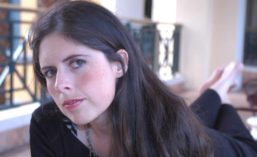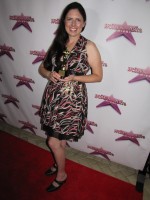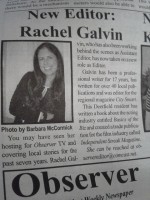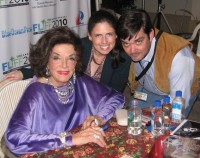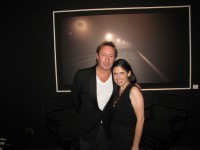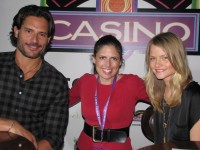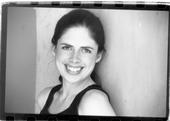By Rachel Galvin (as seen in “Cultural Quarterly”)
Artist Victoria Gitman puts pointillism on its head, adding a new sheen to the style although she doesn’t label her work as such. While most pointillism can best be understood from afar, Gitman’s work is best appreciated up close, very close.
Her collection On Display showcases paintings of beaded vintage purses from the 1920s to 1940s primarily, although lately, she has bought some that are more recent. She finds these muses on eBay or at flea markets. The ones that she finds most interesting have intricate shapes or patterns within them, abstract and defined qualities. Their vaguely squared-off form becomes a canvas in and of itself; the design is an art form within an art form and she interprets them both, re-creating their essence.
The paintings take three months at least, a painstaking process put together bead by bead using tiny brushes to make each individual stroke. The purses with beads are easier to map out than the new fur purses she is painting now.
“I know how long it will take depending on the type of bead. I can say, ‘today I will do 35 beads,’ since [the beaded purse] is composed of a rational, structured grid. But painting fur is like relearning how to paint. In order for the fur to be soft and supple and have an organic quality, I need to handle paint differently. Each type of fur requires a different type of paint handling,” she explained.

She pulled out of a small box a painting of a red and white purse with long fur, each strand individually painted on a pink background. “It reminded me of a Rothko painting,” she said, “[The color blocks] become abstract.”
In her home studio overlooking the ocean on Hallandale Beach, she has a closet with purses that she may or may not use in paintings. “A lot of times, I buy things that I might want to paint and I end up not painting them,” she said.
Nearby stands her simple wooden easel, disposable palettes rolled up on top of boxes on the floor. “I keep the palettes so I see what colors I used. I used to throw everything out. Now, I can remember what colors I used for each painting,” she said.
When starting a painting, even the placement of the purse on the Masonite hardboard becomes a ritual.
“I place the actual purse on the board to determine how much space it needs. I think a lot about where to place it. If I give it two extra inches of space, it is a totally different painting. Balance is part of the design itself. Sometimes, I place it centrally, sometimes lower or higher,” Gitman said. “Then, I let it sit for a day or two to make sure the composition works. Then I cut, sand and gesso the board (four to five coats) and stain it with a thin wash with a color that’s keyed to the purse.”
She also glazes most paintings afterward. “You can paint something and it has a rich quality when it’s wet and then, the next day, it looks dull. [That is why I glaze it.] I don’t have to glaze whites, except maybe the shadows,” she said. “Some old masters used to paint in grisaille and [use glaze for colors].”
She tries not to think about her next work until the one she is working on is complete.
Her process is regimented. She paints six days a week. She is painting by 8 a.m. She may paint for a few hours, grab lunch and go for a walk on the beach before continuing. Her stopping time is dictated by the light that streams through her window blinds. During winter, she may work until 5 p.m., during summer, maybe until 6 or 6:30 p.m.
Next to her easel is a small bookcase filled with art books about those who have inspired her, such as Jean-Auguste-Dominique Ingres, Édouard Manet and Jean-Baptiste-Simeon Chardin.
“I saw a show at the Met in 2000 of Chardin and I was totally enamored. His still lifes are not just descriptive. The peaches feel like a peach. He captures peachness, the essence. You can feel the weight of his dead birds, the feathers,” she said, adding that she hopes to capture the same quality, to capture the essence of the pieces she paints.
Her work has always been about intimate connection and desire. “It is a lot about the kind of tactile response one has to painting. What produces that pictorial desire? The surface of the paint or the image portrayed? An optical take of an abstract work still produces tactile desire – a melding desire for surface and image,” she said.

Another one of her series, her Beauties collection, portrays postcard reproductions of masters’ paintings of women in miniature. By making her work small, she hopes the viewer will have to look very close at every detail. Another group of her Beauties portrays Ingres drawings, portraits in which the faces are very finely rendered and the rest of the image is sketchy.
“I try to reproduce every single line. It is a slow remaking of the mark and it makes every mark so important. The process of reproduction creates a fetish of the mark. There’s a kind of seduction enacted by paper and pencil marks. [People] want to come close. There is a confusion between optical and tactile – the material reality of paper and mark and the image they delineate. [The Ingres pieces that I draw on Mylar are] very precise but also very light … almost like they float. They seem hard to grasp. You want to hold onto the image, but they are not quite there. They are always removed, you cannot quite possess them,” she said.
An early piece was a self-portrait with a remix of an Erasmus quote. His version – “Men are not born, but fashioned” meant they have potential to be anything. Her version “Women are not born, but fashioned” indicates how women are fashioned by the outside world, rather than will; it is a shifting connotation that indicates a profound societal truth.

In 2001, Gitman decided to move from painting women wearing dresses and jewelry to just painting the jewelry itself. Again, she focused on simple shapes and patterns. “I would arrange a necklace in a circle or a bracelet in a straight line. I started thinking in terms of geometry,” she said.
She discovered she needed to paint the actual object in order to capture its individuality.
“Looking at an object closely and carefully, I understand how it feels,” she said. “They have objecthood about them, a sculptural quality. Photographs are a flat image. There is a kind of connection that happens when one works from life … There’s a subtlety and a directness. Something happens when I look at an object. There’s a tactile response and I hope that tactile feeling gets translated.”
Her quest for the mark began at an early age.
“When I was very young, I would always draw in class. My grandmother was an amateur artist. She painted every day. She had a studio in her house. Both my parents were architects. My parents let my sister and I draw on the walls freely. Making marks was totally a part of our daily life. It was not a radical idea to think of making marks of my own someday,” she observed.
Gitman, the recipient of a South Florida Cultural Consortium Visual and Media Artists Fellowship in 1999 and 2011, graduated with a bachelor of arts in humanities with a minor in art history and a bachelor of fine art in painting at Florida International University, summa cum laude. She was also a fellow at the Yale Summer School of Art in Norfolk, Conn.
Gitman learned much by going to museums in locations like New York, Paris, London and Washington D.C. Often, she travels with her sister, but she likes to look at the paintings in solitude.
“When my sister and I get into the museum, we split up and meet up later,” she explained. “I can’t focus on the paintings when someone is there. I learned a lot from going to museums and looking at paintings. I realized painters take time to connect. It is an investment of the whole being. You need to slow down and give the process attention.”
Painting has become her life. She goes to bed early, doesn’t drink, eats a macrobiotic diet and practices Yoga. Her space is open and orderly with pockets of playful chaos, plants in the corner, books on a table, chairs in pairs, pottery on a shelf. But she does break out of the box once in a while to hear classical music at the New World Symphony and to travel, including hiking the Alps, where she was able to get up close and personal with the mountains and discover the pure blueness of the sky.
When Gitman first came to the U. S. from Buenos Aires, Argentina, she had never been on a plane. She moved here in 1987 when she was 14.
“I didn’t speak English. For the first two months, I had no idea of anything. And then, from one day to the next, I suddenly understood. I got straight As, but I never lost my accent … As a child, I used to think it would be the greatest thing in the world to live near the ocean year-round. [Now, I live right on the beach],” she said.
Gitman’s artwork has been seen in galleries around the country and locally at the Bass Museum, the Museum of Art | Fort Lauderdale, the Art & Culture Center of Hollywood and elsewhere. Her next exhibition will be at the David Nolan Gallery in New York next winter.
She said she prefers to show a few pieces at a time rather than a huge collection, in hopes of leading visitors to better appreciate the pieces before them.
To find out more about Victoria Gitman, visit www.davidnolangallery.com/artists/victoria-gitman/biography.
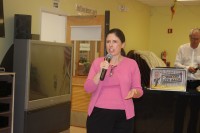 Pictured: Rachel Galvin speaks to seniors at NE Focal Point
Pictured: Rachel Galvin speaks to seniors at NE Focal Point